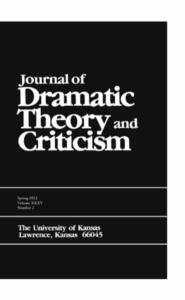Journal of Dramatic Theory and Criticism, 35.2 (special section – #PerformativeX)
Opening Section
In a chapter titled “Performativity” in the most recent edition of his Performance Studies: An Introduction, Richard Schechner tells students that the terms performative and performativity “are very difficult to pin down. These terms have acquired a wide range of meanings. Sometimes they are used precisely, but often they are used loosely to indicate something that is ‘like a performance’ without actually being a performance in the orthodox or formal sense.” This third edition of Performance Studies is  committed to the idea that the term is a slippery one, but Schechner nominally proposes to sort out the confusion: there is the noun performative and there is the adjective performative. The noun indicates what J. L. Austin called a performative utterance: a phrase that makes something happen with the force of its iteration rather than a phrase that describes something. The adjective performative, on the other hand, “inflects what it modifies with performance-like qualities.” So far, so good. It is in approximately these two senses that Sara Warner calls a Lavender Menace zap “performative in both senses of the term: it was ‘staged’ and consequential.” The zap is like a performance; it also does things in the Austinian sense. But to speak more precisely still, it is not quite accurate to say that the zap is like a performance. It is a performance, as Warner describes it, and I take her to mean here that the zap (to modify Schechner’s definition) is like theatre without being theatre in the formal sense.
committed to the idea that the term is a slippery one, but Schechner nominally proposes to sort out the confusion: there is the noun performative and there is the adjective performative. The noun indicates what J. L. Austin called a performative utterance: a phrase that makes something happen with the force of its iteration rather than a phrase that describes something. The adjective performative, on the other hand, “inflects what it modifies with performance-like qualities.” So far, so good. It is in approximately these two senses that Sara Warner calls a Lavender Menace zap “performative in both senses of the term: it was ‘staged’ and consequential.” The zap is like a performance; it also does things in the Austinian sense. But to speak more precisely still, it is not quite accurate to say that the zap is like a performance. It is a performance, as Warner describes it, and I take her to mean here that the zap (to modify Schechner’s definition) is like theatre without being theatre in the formal sense.
The fact is that there are more than these two meanings of performative. Frequent uses of the term on social media mean “trickily or slyly false,” extending a typical antitheatrical prejudice from theatrical to performative. And although a great deal can be said about Austinian performatives and ways of using the word in its Austinian sense, for this essay I focus on some shades of meaning that differentiate Warner’s use (like theatre) and Schechner’s definition (like performance). That is, in a nod to Austin’s own classificatory tendencies, especially visible in the final lecture of How to Do Things with Words, I trace the range of uses of performative current within theatre and performance studies. There has been an extraordinary and puzzling laxity around uses of this word by editors and journals in the field so that performative has become not only hard to pin down, as Schechner would have it, but, as I argue here, consistently and reliably infelicitous. In the following pages I track five distinct uses of performative within theatre and performance studies through some of the foundational texts of the discipline, paying close attention to Victor Turner, Richard Schechner, and Dwight Conquergood. I also address the emergence of the word in some of the field’s key journals. This exploration is not designed to be exhaustive; this is not a history of performance nor even a history of the word performative as such. I am concerned, rather, with how the word has been taken up by scholars of performance and with addressing the infelicities that attend the word as it is used, cited, and performatively deployed within performance studies.


